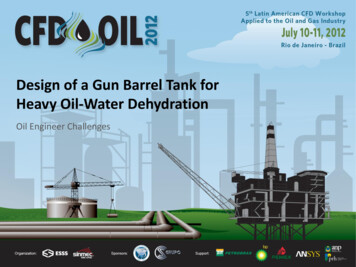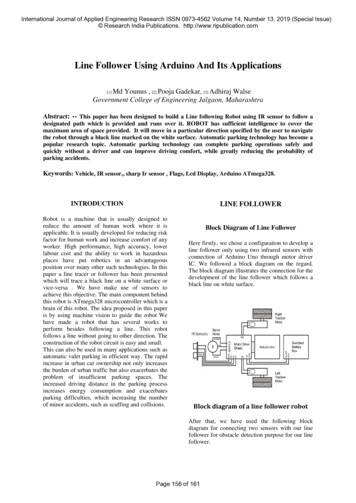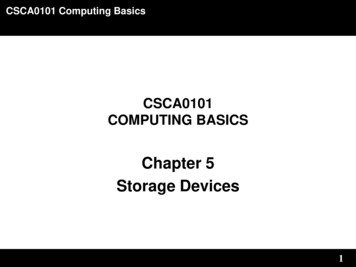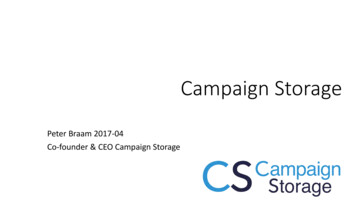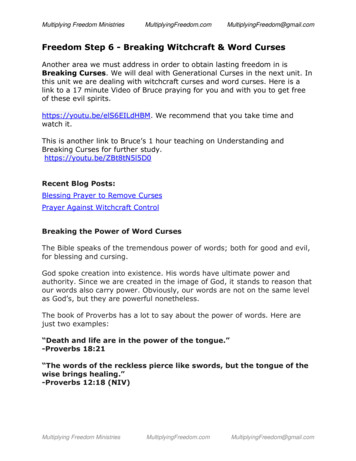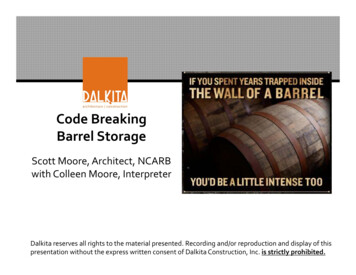
Transcription
Code BreakingBarrel StorageScott Moore, Architect, NCARBwith Colleen Moore, InterpreterDalkita reserves all rights to the material presented. Recording and/or reproduction and display of thispresentation without the express written consent of Dalkita Construction, Inc. is strictly prohibited.
IntroductionsScott Moore Master of Architecture from the University of Illinois Urbana‐Champaign Nationally Certified Architect through NCARB Currently licensed in CO, KY, MA, MN, MO and UT Over 25 years of experience in the design & building industry Over 10 years of experience in distillery design and construction Over 15 year of experience as a general contractor, Class ‘A’ SupervisorDalkita reserves all rights to the material presented. Recording and/or reproduction and display of thispresentation without the express written consent of Dalkita Construction, Inc. is strictly prohibited.
OverviewA. Codes A (very) Brief HistoryB. Code HierarchyC. What do wooden cask or barrelexceptions actually mean?D. H‐3 Requirements‐ Basic & Barrel ExceptionsE. The Ventilation ExceptionF. Other Related Issues‐ Specialty Codes‐ High Piled Storage‐ New Threats to Cask Storage* Fine print is often critical in understanding the meaning of Codes. This presentation is based on the 2015 ICC Codes and the 2015 NFPA.
CODES: A BRIEF HISTORYFirst Building Code in the U.S.
CODES: A BRIEF HISTORY
CODES: A BRIEF HISTORY
CODES: A BRIEF HISTORYThe International Code Council (ICC) was established in 1994 asa non‐profit organization dedicated to developing a single set ofcomprehensive and coordinated national model construction. Building Officials and Code Administrators International, Inc.(BOCA), International Conference of Building Officials (ICBO) Southern Building Code Congress International, Inc. (SBCCI).
CODES: A BRIEF HISTORY
CODES: A BRIEF HISTORY
CODES: A BRIEF HISTORYNFPA 1: Fire CodeNFPA 2: Hydrogen Technologies CodeNFPA 3: Recommended Practice on Commissioning and Integrated Testing of FireProtection and Life Safety SystemsNFPA 4: Standard for Integrated Fire Protection and Life Safety System TestingNFPA 10: Standard for Portable Fire ExtinguishersNFPA 10A: Recommended Good Practice for the Maint and Use of Portable FireExtinguishersNFPA 11: Standard for Low‐, Medium‐, and High‐Expansion FoamNFPA 11A: Standard for Medium‐ and High‐Expansion Foam SystemsNFPA 11B: Standard on Synthetic Foam and Combined Agent SystemsNFPA 11C: Standard for Mobile Foam ApparatusNFPA 12: Standard on Carbon Dioxide Extinguishing SystemsNFPA 12A: Standard on Halon 1301 Fire Extinguishing SystemsNFPA 12B: Standard on Halogenated Fire Extinguishing Agent Systems Halon 1211NFPA 13: Standard for the Installation of Sprinkler SystemsNFPA 13D: Standard for the Installation of Sprinkler Systems in One‐ and Two‐FamilyDwellings and Manufactured HomesNFPA 13E: Recommended Practice for Fire Department Operations in PropertiesProtected by Sprinkler and Standpipe SystemsNFPA 13R: Standard for the Installation of Sprinkler Systems in Low‐Rise ResidentialOccupanciesNFPA 14: Standard for the Installation of Standpipe and Hose SystemsNFPA 15: Standard for Water Spray Fixed Systems for Fire ProtectionNFPA 16: Standard for the Installation of Foam‐Water Sprinkler and Foam‐Water SpraySystems
So we're back to courting the Fire Marshall's approval. Local code allowsmassive amounts of bulk liquor to be stored in wooden casks at distilleries, orin individual glass containers at retail locations, but not in individual glasscontainers at distilleries.We want our boys to be safe if they respond to a distillery fire, butthe inconsistencies in the code are really frustrating.
CODES: A ROADMAP
CODES: A ROADMAP
CODES: A ROADMAP
CODES: A ROADMAPOR
CODES: THE LINGO (VOCAB)Abbrev.Short for ThisAHJAuthority Having Jurisdiction (city, county, fire district)ICCInternational Code CouncilIBCInternational Building CodeIFCInternational Fire CodeIMCInternational Mechanical CodeNFPANational Fire Protection AssociationCFMCubic Foot per MinuteSFMAQLFLSquare Foot or Square FeetMaximum Allowable QuantityLower Flammable Limit
CODES: THE LINGO (VOCAB)TermMeansPerformanceLanguageIndicates an intended result and requires a design that performsto result in the code intention.PrescriptiveLanguagegiving exact rules, directions, or instructions about how youshould do somethingCommentaryNot code but published to help determine the reasoning behindthe rules.
barrels areexempt right?!
OVERVIEW: BARREL EXCEPTIONSWhen do the IFC Exceptions Apply to create Modified H‐3?IBC414.31 CFM/SF Ventilation414.5.1IFCSee IFC & IMCBarrel ExceptionExplosion ControlSee IFCBarrel Exception414.5.3Spill ControlSee IFCBarrel Exception414.5.3Secondary ContainmentSee IFCBarrel Exception415.5Emergency AlarmSame415.4SprinklersSame415.625% Ext. WallSame508.3.3 ex.1 Min. 1 hr. Separation2015 ICC Code ReferencesSame
WHAT IS H‐3?SECTION 307 HIGH‐HAZARD GROUP HFLAMMABLE AND COMBUSTIBLE LIQUIDS[F] 307.1 High‐hazard Group H. High‐hazard Group H occupancyincludes, among others, the use of a building or structure, or aportion thereof, that involves the manufacturing, processing,generation or storage of materials that constitute a physical orhealth hazard in quantities in excess of those allowed in controlareas complying with Section 414, based on the maximumallowable quantity limits for control areas set forth in Tables 307.1(1)and 307.1(2).If quantities exceedMAQs, occupancy is H‐3for barrel storage.
WHAT DO I NEED FOR H‐3?IBC 307.5You are considered an H‐3 Occupancy if ANY of the following apply to Class 1, 2, or3A flammable or combustible liquids : Stored/used in normally closed containers or systems Liquids are pressurized at 15 PSIPrimary Added requirements of H‐3 Occupancy: 25% perimeter on exterior wall(if over 500 SF dispensing or 1000 SF Storage per 415.5 – exceptions #1 & 2) Must be Sprinklered Spill Control Secondary Containment 1 cfm/sf Continuous Ventilation & Mechanical Code w/ UninterruptablePower Source (UPS) Deflagration Control2012 Fire Code 911.3 refers to NFPA 69: “Explosion control by prevention.”Table 414.5.1 Footnote e Open Use and Dispensing Only Emergency Alarms Mandatory Minimum 1 hr Fire Separation from other Occupancies
BARRELS & MAQsExcerpted from TABLE 307.1 (1), 2015 International Building Codeand TABLE 5003.1.1(1) in 2015 International Fire Code“MAXIMUM ALLOWABLE QUANTITY PER CONTROL AREA OF HAZARDOUS MATERIALS POSING A PHYSICAL HAZARD”STORAGE bUSE‐CLOSED SYSTEMS bLIQUID GALLONS(POUNDS)GAS(CUBICFEET ATNTP)SOLID POINDS(CUBIC FEET)LIQUID GALLONS(POUNDS)Note qN/AN/ANote 0d120dN/AN/A10d30dLIQUID GALLONS(POUNDS)GAS(CUBICFEET ATNTP)SOLIDPOUNDS(CUBIC FEET(Note qN/AN/AMATERIALCLASSGROUP WHEN MAX.ALLOW. QTY.EXCEEDEDSOLIDPOUNDS(CUBIC FEET)CombustibleDustN/AH‐2CombustibleLiquid c, i23A3BH‐2 or H‐3H‐2 or H‐3N/AN/A120 d,e330 d,e13,200 e,fFlammableLiquid c1A1B and 1CH‐2or H‐3N/A30 d,e120 d,eUSE‐OPEN SYSTEMS bc. “alcoholic beverages in retail and wholesale occupancies provided that the liquids are packaged inindividual containers not exceeding 1.3 gallons.”d. “(MAQs) increased 100 percent with automatic sprinkler system . Where Note e also applies, theincrease for both notes shall be applied accumulatively.”e. “(MAQs) increased 100 percent when stored in approved storage cabinets, day boxes, gas cabinetsor exhausted enclosures or in listed safety cans both notes shall be applied accumulatively.”f.“The permitted quantities shall not be limited in a building equipped throughout with an automaticsprinkler system in accordance with Section 903.3.1.1”q.“ (Combustible Dust in 2012 code) manufactured, generated in a manner that the concentrationand conditions create a fire or explosion hazard ”
WHAT’S IN THE BARRELS?FLAMMABLE LIQUID. A liquid having a closedcup flash point below 100 F(38 C). Flammableliquids are further categorized into a groupknown as Class 1liquids. The Class 1category issubdivided as follows:Table 2‐1.1Flash and Fire Points of Alcohol‐Water Solutions (DISCUS)Alcohol(Vol. %)Tag ClosedCup FlashPoint2Tag OpenCup FlashPoint3Fire Point4Class IB LiquidsClass 1A. Liquids having a flash point below73 F(23 C) and a boiling point below 100 F(38 C).Class 1B. Liquids having a flash point below73 F(23 C) and a boiling point at or above100 F(38 C).Class 1C. Liquids having a flash point at orabove 73 F(23 C) and below 100 F(38 C).95%63 F (17 C)70 F (21 C)70 F(21 C)90%65 F (18 C)72 F (22 C)72 F(22 C)80%68 F (20 C)76 F (24 C)76 F(24 C)70%70 F (21 C)80 F (27 C)80 F(27 C)60%72 F (22 C)86 F (30 C)87 F(30 C)Class IC Liquids (below 55%)50%75 F (24 C)90 F (32 C)94 F(34 C)40%79 F (26 C)96 F (36 C)102 F(39 C)30%85 F (29 C)104 F (40 C)113 F(45 C)20%97 F (36 C)119 F (48 C)136 F(58 C)Non‐flammable liquid (below 20%)10%120 F (49 C)150 F (66 C)‐‐‐
BARRELSExcerpted from TABLE 307.1 (1), 2015 International Building Codeand TABLE 5003.1.1(1) in 2015 International Fire Code“MAXIMUM ALLOWABLE QUANTITY PER CONTROL AREA OF HAZARDOUS MATERIALS POSING A PHYSICAL HAZARD”STORAGE bUSE‐CLOSED SYSTEMS bLIQUID GALLONS(POUNDS)GAS(CUBICFEET ATNTP)SOLID POINDS(CUBIC FEET)LIQUID GALLONS(POUNDS)Note qN/AN/ANote 0d120dN/AN/A10d30dLIQUID GALLONS(POUNDS)GAS(CUBICFEET ATNTP)SOLIDPOUNDS(CUBIC FEET(Note qN/AN/AMATERIALCLASSGROUP WHEN MAX.ALLOW. QTY.EXCEEDEDSOLIDPOUNDS(CUBIC FEET)CombustibleDustN/AH‐2CombustibleLiquid c, i23A3BH‐2 or H‐3H‐2 or H‐3N/AN/A120 d,e330 d,e13,200 e,fFlammableLiquid c1A1B and 1CH‐2or H‐3N/A30 d,e120 d,eUSE‐OPEN SYSTEMS bd. “(MAQs) increased 100 percent with automatic sprinkler system . Where Note e also applies, theincrease for both notes shall be applied accumulatively.”MAQs are 120/30(240/60 sprinkled)53 53 53 over limit
BARRELSSECTION 414SPECIAL REQUIREMENTS – HAZARDOUS MATERIALS[F] 414.3 Ventilation. Rooms, areas or spaces in which explosive,corrosive, combustible, flammable or highly toxic dusts, mists,fumes, vapors or gases are or may be emitted due to theprocessing, use, handling or storage of materials shall bemechanically ventilated where required by this code, theInternational Fire Code or the International Mechanical Code.VentilationNOT EXHAUSTSee Fire CodeSee Mechanical Code
VENTILATION
BARRELSCHAPTER 50HAZARDOUS MATERIALS – GENERAL PROVISIONSSECTION 5001GENERAL5001.1 Scope. “ This chapter shall apply to all hazardous materials,including those materials regulated elsewhere in this code, except thatwhere specific requirements are provided in other chapters [in thecase of] multiple hazards, all hazards shall be addressed.”Exceptions:10. “The storage of distilled spirits and wines in woodenbarrels and casks.”Barrels ExemptIFC requiresno ventilation
BARRELSCHAPTER 50HAZARDOUS MATERIALS – GENERAL PROVISIONSSECTION 5001GENERAL5001.1 Scope. FROM THE COMMENTARY Exception 10 covers the storageof distilled spirits and wines in wooden barrels and casks. Thisstatement may appear to exempt all requirements for these productsfrom being Group H occupancy. However, the IBC will still classifythe storage area as a Group H occupancy if the amounts exceed themaximum allowable quantities (MAQs) per control area listed inTable 307.1(1) of that code for flammable or combustible liquids.All requirements for a Group H occupancy in the IBC are stillapplicable; however, any requirements from the code are not. The Commentary tells usbarrels and casks are NOT exempt fromIBC H‐3Commentary is NOT code, but IS a guideto interpreting the code.
HANDY HANDOUT
BARRELSCHAPTER 57FLAMMABLE AND COMBUSTIBLE LIQUIDSSECTION 5701GENERAL5701.2 Nonapplicability. This chapter shall not apply to liquids asotherwise provided in other laws or regulations or chapters of thiscode, including: 10. The storage of distilled spirits and wines in wooden barrels andcasks.Barrels and casks areNonapplicable to thischapter.IFC requires no ventilation
BARRELSCOMMENTARY ONCHAPTER 57FLAMMABLE AND COMBUSTIBLE LIQUIDSSECTION 5701GENERAL5701.2 Nonapplicability. Item 10 makes the storage of distilled spirits and wines in woodenbarrels and casks exempt from this chapter. Although their contentsare classified as flammable liquids, the containers do not pose therupture hazard as do other containers. Barrels and casks will leak theircontents and contribute to the fire as the metal bands that secure thestaves expand and loosen. Even this hazard is generally mitigated bythe operation of automatic sprinklers that prevent the fire fromprogressing to the point where the metal bands get hot enough toexpand. A similar exception also appears in Section 5001.1Barrels do not ruptureSprinklers greatly mitigate riskCommentary is NOT code but IS aguide to interpreting the code.
CODE: NFPA 1NFPA 1Chapter 66 Flammable and Combustible Liquids66.1.2 Where the provisions of this chapter or NFPA 30 conflict withthe provisions of Chapter 60, the provisions of this chapter andNFPA 30 shall apply.66.9 Storage of Liquids in Containers — General Requirements.66.9.1 Scope.66.9.1.4 This section shall not apply to the following:(7) Distilled spirits and wines in wooden barrels or casks[30:9.1.4]
CODE: NFPA 30NFPA 30Chapter 9 Storage of Liquids in Containers —GeneralRequirements9.1 Scope.9.1.4 This chapter shall not apply to the following:(7) Distilled spirits and wines in wooden barrels or casks
BARRELSSECTION 403MECHANICAL VENTILATION 403.2 Outdoor air required. “ Ventilation supply systems shall bedesigned to deliver the required rate of outdoor airflow to thebreathing zone within each occupiable space.”“Exception: Where the registered design professionaldemonstrates that an engineered ventilation systemdesignthe maximumconcentration ofWewillwillpreventcome backtocontaminantsthedealminimumventilation andwith required rate of outdoorair shall be reducedIMC in accordance with such engineeredsystem design.” 510.2 Hazardous Exhaust where required.1. Flammable liquid vapor in excess of 25% of the LFL
BARRELSCHAPTER 4[F] 414.5.1 Explosion Control. Explosion control shall be provided inaccordance with the International Fire Code as required by Table 414.5.1 wherequantities of hazardous materials specified in that table exceed the maximumallowable quantities in Table 307.1.(1) or where a structure, room or space isoccupied for purposes involving explosion hazards as required by Section 415 orthe International Fire Code.[F] 414.5.2 Emergency or standby power. Where required by the InternationalFire Code or this code, mechanical ventilation, treatment systems, temperaturecontrol, alarm, detection or other electrically operated systems shall beprovided with emergency or standby power in accordance with Section 2702.For storage and use areas for highly toxic or toxic materials, see Sections6004.2.2.8 and 6004.3.4.5 of the International Fire Code.Explosion control, emergency power, spill control, drainage, andcontainment all refer to the IFC where barrels are exempt.Therefore these items are not required for cask storage.Note: explosion control is inherently provided with the 0.06cfm/sf of ventilation.
BARRELS[F] 414.5.3 Spill control, drainage and containment. Rooms,buildings or areas occupied for the storage of solid and liquidhazardous materials shall be provided with a means to control spillageand to contain or drain off spillage and fire protection waterdischarged in the storage area where required in the International FireCode. The methods of spill control shall be in accordance with theInternational Fire Code.Explosion control, emergency power, spill control, drainage, andcontainment all refer to the IFC where barrels are exempt.Therefore these items are not required for cask storage.Note: explosion control is inherently provided with the 0.06cfm/sf of ventilation.
BARRELS[F] 415.4 Automatic sprinkler system. Group H occupancies shall beequipped throughout with an automatic sprinkler system in accordancewith Section 903.2.5[F] 415.5 Emergency alarms. Emergency alarms for the detection andnotification of an emergency condition in Group H occupancies shall beprovided as set forth herein.[F] 415.5.1 Storage. An approved manual emergency alarm systemshall be provided in buildings, rooms or areas used for storage ofhazardous materials. Emergency alarm‐initiating devices shall beinstalled outside of each interior exit or exit access door of storagebuildings, rooms or areas. Activation of an emergency alarm‐initiatingdevice shall sound a local alarm to alert occupants of an emergencysituation involving hazardous materials.Sprinklers, emergency alarm are required.IFC?
BARRELS[F] 415.6.1.3 Groups H‐2 and H‐3. Group H‐2 and H‐3 occupanciesshall be set back not less than 50 feet (15 240 mm) where a detachedbuilding is required (see Table 415.6.2).The detached building is never required for H‐3 spirits in casks
BARRELS508.3.3 Separation. No separation is required between nonseparatedoccupancies.Exceptions:1. Group H‐2, H‐3, H‐4 and H‐5 occupancies shall be separated from allother occupancies in accordance with Section 508.4. H‐3Barrel StorageF‐1DistilleryBarrels Mixedwith DistilleryA‐2Tasting RoomA‐2Tasting Room
PEOPLE NEED TO SEE THE STILLS!
BARRELS508.3.3 Separation. No separation is required between nonseparatedoccupancies.Exceptions:1. Group H‐2, H‐3, H‐4 and H‐5 occupancies shall be separated from allother occupancies in accordance with Section 508.4. A minimum of 1 hour separationfrom other occupancies is required.The IFC is not referenced.Therefore, the barrel exceptions do not apply.Typically, in smaller buildings, the entire distillery (except the H‐3barrel room) is a non‐separated mixed use with either F‐1 or A‐2being the most restrictive and the H‐3 room barrel separatedaccordingly.
BARRELSExcerpted from: TABLE 508.4REQUIRED SEPARATION OF OCCUPANCIES (HOURS)OccupancyH‐3 SNSA, E23Ra2NPF‐2, S‐2b, U23Be, F‐1, M, S‐112H‐1NPNPH‐21NPH‐3, H‐41dNPS sprinkledNS not sprinkledN No separation requirementNP Not Permitteda. See Section 420b. Required separation from areas used onlyfor private or pleasure vehicles shall bereduced by 1 hour but not less than 1/2hour.d. Separation is not required betweenoccupancies of the same classification.e. See Section 422.2 for ambulatory carefacilities.
CIRCLE BACK: BARREL EXCEPTIONSWhen do the IFC Exceptions Apply to create Modified H‐3?IBC414.31 CFM/SF Ventilation414.5.1IFCSee IFC & IMCBarrel ExceptionExplosion ControlSee IFCBarrel Exception414.5.3Spill ControlSee IFCBarrel Exception414.5.3Secondary ContainmentSee IFCBarrel Exception415.5Emergency AlarmSame415.4SprinklersSame415.625% Ext. WallSame508.3.3 ex.1 Min. 1 hr. Separation2015 ICC Code ReferencesSame
BARRELSSECTION 414Special Requirements – Hazardous Materials[F] 414.3 Ventilation. Rooms, areas or spaces in which explosive,corrosive, combustible, flammable or highly toxic dusts, mists, fumes,vapors or gases are or storage of materials shall be mechanicallyventilated where required by this code, the International Fire Code orthe International Mechanical Code.Ventilation NOT EXHAUSTSee Fire CodeSee Mechanical Code
BARRELSExcerpted from: TABLE 403.3.1.1MINIMUM VENTILATION RATESOCCUPANCYCLASSIFICATIONOCCUPANTDENSITY #/1000FT2 aPEOPLEOUTDOORAIRFLOW RATE INBREATHINGZONE,Rp CFM/PERSONAREA OUTDOORAIRFLOW RATE INBREATHINGZONE,aR CFM/FT2 aEXHAUSTAIRFLOW RATECFM/FT2 aStorageRepair garages,enclosed parkinggarages ‐‐0.06 CFM/FT2 required forbarrel storage ventilation
BARRELSSECTION 403MECHANICAL VENTILATION403.1 Ventilation system. Mechanical ventilation shall be providedby a method of supply air and return or exhaust air except thatmechanical ventilation air requirements for Group R‐2, R‐3, and R‐4occupancies three stories and less in height above grade plane shall beprovided by an exhaust system, supply system or combination thereof.The amount of supply air shall be approximately equal to the amountof return and exhaust air. The system shall not be prohibited fromproducing negative or positive pressure. The system to conveyventilation air shall be designed an installed in accordance withChapter 6. ventilation is provided by supply airand return OR exhaust. If we used supply & return air, we still need 0.06 CFM of outdoor air. Adding air means we have to move it out – i.e. exhaust. We typically take exhaust from within 12” of the floor due to theproperties of alcohol vapor being heavier than air The remaining fumes to stay under 25% of LFL.
BARRELSSECTION 401GENERAL401.1 Scope. This chapter shall govern the ventilation of spaces withina building intended to be occupied. Mechanical exhaust systems,including exhaust systems serving clothes dryers and cookingappliances; hazardous exhaust systems; dust, stock and refuseconveyor systems; smoke control systems; energy recovery ventilationsystems and other systems specified in Section 502 shall comply withChapter 5.Because we are ventilating withMechanical Exhaust vs.Supply/Return Air – We must go toChapter 5 of the IMC.
BARRELSSECTION 401GENERAL401.1 Scope. This chapter shall govern the ventilation of spaces withina building intended to be occupied. Mechanical exhaust systems,including exhaust systems serving clothes dryers and cookingappliances; hazardous exhaust systems; dust, stock and refuseconveyor systems; smoke control systems; energy recovery ventilationsystems and other systems specified in Section 502 shall comply withChapter 5. FROM COMMENTARYThis section establishes the scope Smokecontrol systems, smoke venting, mechanicalexhaust systems and combustion air suppliesare not within the scope of this chapter but areregulated by other sections of the code Chapter 5 addresses exhaust systems It may be inferred, and supported bycommentary, that Chapter 5requirements apply to cask storage.
BARRELSThe following slides intend to showIMC Chapter 5 requirementsdo not exceedIMC Chapter 4’s requirementof 0.06 CFM/SF2and are supplanted bythe IFC exceptions.
BARRELSSECTION 502REQUIRED SYSTEMS502.1 General. An exhaust system shall be provided, maintainedand operated as specifically required by this section and for alloccupied areas where machines, vats, tanks, furnaces, forges,salamanders and other appliances, equipment and processes insuch areas produce or throw off dust or particles sufficiently light tofloat in the air, or which emit heat, odors, fumes, spray, gas orsmoke, in such quantities so as to be irritating or injurious to healthor safety.
BARRELSSECTION 502REQUIRED SYSTEMS502.1 General. An exhaust system shall be provided, maintainedand operated as specifically required by this section and for alloccupied areas where machines, vats, tanks, furnaces, forges,salamanders and other appliances, equipment and processes insuch areas produce or throw off dust or particles sufficiently light tofloat in the air, or which emit heat, odors, fumes, spray, gas orsmoke, in such quantities so as to be irritating or injurious to healthor safety.The commentary clarifies FROM COMMENTARY Exhaust systemsmust be designed to collect and remove thethe intent is to requirecontaminants This section is written inthe code officialperformance language and requires case-by-caseand designerevaluation by the designer and the code official toto work togetherdetermine the quantity and type of contaminationto design a systempresent, whether any action needs to be taken appropriate tothe specific situation.
BARRELSSECTION 502REQUIRED SYSTEMS502.1 General. An exhaust system shall be provided, maintainedand operated as specifically required by this section and for alloccupied areas where machines, vats, tanks, furnaces, forges,salamanders and other appliances, equipment and processes insuch areas produce or throw off dust or particles sufficiently light tofloat in the air, or which emit heat, odors, fumes, spray, gas orsmoke, in such quantities so as to be irritating or injurious to healthor safety.Using historic data FROM COMMENTARY Exhaust systemsfor alcohol lossmust be designed to collect and remove theduring time in caskcontaminants This section is written in(Angel’s Share)performance language and requires case-by-casewe can demonstrateevaluation by the designer and the code official to0.06 CFM/SF2 ismore than adequatedetermine the quantity and type of contaminationto exhaust the vaporpresent, whether any action needs to be taken faster than it accumulatesto 25% of the LFL.Thereby addressing andmitigating contaminates.
BARRELSSECTION 502EXHAUST SYSTEMS[F]502.8.1 Storage in excess of the maximum allowable quantities. Indoorstorage areas and storage buildings for hazardous materials in amountsexceeding the maximum allowable quantity per control area [F] 502.8.1.1 System requirements. Exhaust ventilation systems shallcomply with all of the following: 2. Mechanical ventilation shall be provided at a rate of not less than1 cfm per square foot [0.00508 m3/(s*m2)] of floor area over thestorage area.3. The systems shall operate continuously 1 CFM/SF2required whereMAQs exceeded4. A manual shutoff control shall be provided outside of theroom labeled: VENTILATION SYSTEM EMERGENCY SHUTOFF.5. For fumes or vapors that are heavier than air, exhaust shall betaken from a point within 12 inches (305 mm) of the floor.6. The location of both the exhaust and inlet air openings shall bedesigned to provide air movement across all portions of the flooror room to prevent the accumulation of vapors.7. The exhaust air shall not be recirculated to occupied areas
BARRELS
BARRELSSECTION 502EXHAUST SYSTEMS[F] 502.8 Hazardous materials – general requirements. Exhaust ventilationsystems for structures containing hazardous materials shall be provided asrequired in Sections 502.8.1 through 502.8.5. FROM COMMENTARY Chapter 50 of the IFCcontains guidance for the storage, dispensing, use andhandling of hazardous materials. Section 5004.3 of theIFC contains the same ventilation requirements asSections 502.8.1 and 502.8.1.1 of the code.The Commentary indicates the IFCcontains the same ventilation requirements.The IFC has no ventilation requirements for barrel storagebecause of the exceptions.Therefore, ventilation (exhaust) is NOT REQUIRED by 502.8 of the IMC.
BARRELSSECTION 502EXHAUST SYSTEMS[F] 502.8 Hazardous materials – general requirements. Exhaust ventilationsystems for structures containing hazardous materials shall be provided asrequired in Sections 502.8.1 through 502.8.5. FROM COMMENTARY Chapter 50 of the IFCcontains guidance for the storage, dispensing, use andhandling of hazardous materials. Section 5004.3 of theIFC contains the same ventilation requirements asSections 502.8.1 and 502.8.1.1 of the code.BUT, this assumption could be challenged.SECTION 102APPLICABILITY[A] 102.1 General. Where there is a conflict between a general requirementand a specific requirement, the specific requirement shall govern. Where, ina specific case, different sections of this code specify different materials,methods of construction or other requirements, the most restrictive shallgovern.
BARRELSSECTION 502EXHAUST SYSTEMS[F]502.9.5 Flammable and combustible liquids. Exhaust ventilationsystems shall be provided as required by Sections Unless otherwisespecified this section shall apply to any quantity of flammable andcombustible liquids.Exception: This section shall not apply to flammable andcombustible liquids that are exempt from the International FireCode. FROM COMMENTARY: Minimum requirements for mechanicalexhaust ventilation for inside areas in which flammable orcombustible liquids are stored are contained in Section 5004.3 ofthe IFC and Section 502.8.1.1 of the code. The use of naturalventilation as an alternative to mechanical ventilation is subject toapproval by the code official (see commentary, Sections 502.9.5.1through 502.9.5.5).
BARRELSIMCSECTION 510HAZARDOUS EXHAUST SYSTEMS510.2 Where required. A hazardous exhaust system shall berequired wherever operations involving the handling or processingof hazardous materials, in the absence of such exhaust systems andunder normal operating conditions, have the potential to createone of the following conditions:1.A flammable vapor, gas, fume, mist or dust is present inconcentrations exceeding 25 percent of the lowerflammability limit of the substance for the expected roomtemperature.
BARRELSSECTION 502EXHAUST SYSTEMS[F]502.9.5 Flammable and combustible liquids.Section 502.9.5 is specific to flammable and combustible liquids.Due to this specificity, it is the key article pertaining to our liquid.It specifically exempts liquids that are exempt in the IFC.Spirits in casks are exempt from ventilation requirements in the IFC.They are therefore exempt from exhaust requirements here in theIMC.Only the warehouse ventilation rate requirement still applies.
BARRELSSpecialty Codes
STACKING METHODSDUNNAGEPALLETIZED ON ENDEND STACKEDSTEEL RACKSWOOD RICKSPALLETIZED WINE RACKStorage over 6’? High Piled Storage RequirementsTOTES No Exception for BarrelsHigh‐Hazard Commodity ClassSmoke VentsDesignated Piles & AislesAccess Doors
COMING SOON IFCCHAPTER 32HIGH‐PILED COMBUSTIBLE STORAGEBarrels are not exempt from the requirements of this chapter.If your district is not using IFC, then similar requirements are foundthroughout various NFPA documents.Barrels are High Hazard Commodity and therefore, if stacked over 6’tall, are considered high piledSome additional building elements that may be required for HPCSinclude ‐Smoke vents or ESFR (Early Suppression Fast Response)sprinklers‐ Fire department access every 100’.‐ Draft curtains‐ Designated aislesWatch for our next specialty presentationor webinar on this subject.
CURRENT RESEARCH Factory Mutual ‐ now FM Global, an insura
LIQUID GALLONS (POUNDS) GAS (CUBIC FEET AT NTP) SOLID POINDS (CUBICFEET) LIQUID (POUNDS) Combustible Dust N/A H‐2Note qN/A N/ANote qN/A N/A Note qN/A Combustible Liquid c, i 2 3A 3B H‐2 or H‐3 H‐2 dor H‐3 N/A N/A 120 d,e 330 ,e 13,200 e,f N/A N/A 120d 330d 13,200f N/A N/A 30d 80d 3,300f Flammable d,e Liquid c 1A 1Band d,e1C H‐2 or H .
